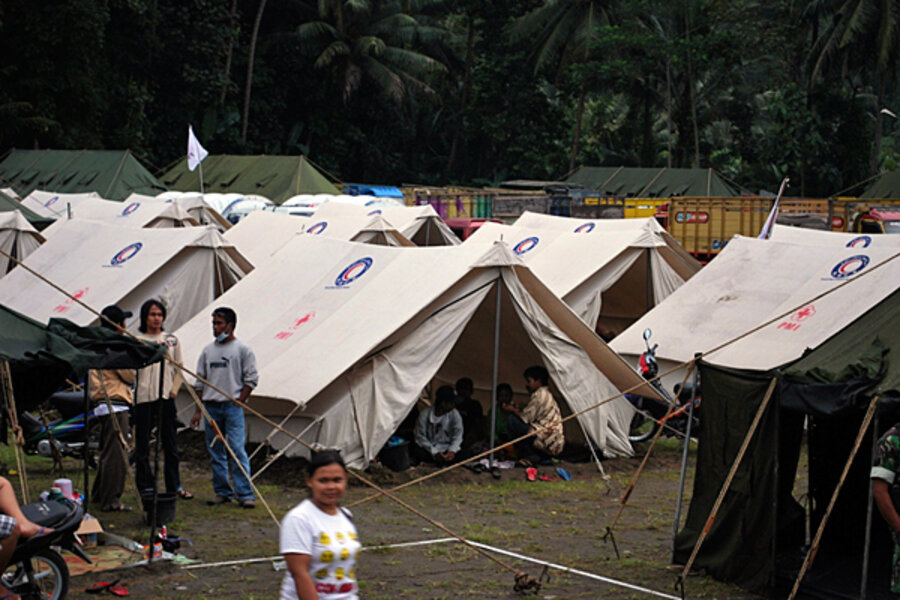Rescue workers, officials debate warning system as Indonesian volcano erupts again
Loading...
| Jakarta, Indonesia
As the death toll from Monday’s tsunami in west Sumatra crept close to 350 people, Indonesian officials debated the efficiency of an early warning system put in place after the 2004 tsunami.
Rescue workers 800 miles east of the affected tsunami region also scrambled to continue assisting the nearly 40,000 people displaced by the eruption of Mount Merapi, which blasted a second round of hot ash and debris on Thursday evening.
The responses to back-to-back disasters this week and revelations about the possibility that the warning system did not have proper upkeep highlight the difficulties the government faces in trying to put together an efficient disaster management system. Indonesia’s economy has been soaring lately, but it still struggles with widespread corruption and budget shortfalls that prevent infrastructure development.
Monitor List: World's 5 biggest tsunamis
No warning alarm
The 10-foot wave that followed a 7.7-magnitude earthquake near the Mentawai Islands failed to set off the alarm on an expensive alert system made up of buoys that one Indonesian official says were tampered with.
Ridwan Jamaluddin, deputy chairman of the government agency for the assessment and application of technology, told the Financial Times that the buoys have been vandalized several times and have had to be removed for repairs and that could be the reason why the the tsunami was such a surprise.
The news came as rescue workers got a clearer picture of the extent of damage on the remote Mentawai Islands. The wave that hit the island chain uprooted trees and swept wood and bamboo homes clean from their foundations.
IN PICTURES: Indonesia tsunami
Though surfers and other small organizations were already in the region and were able to provide immediate assistance, poor weather and the remoteness of the affected area meant government search teams only began arriving by sea and by air to the islands Wednesday.
Rescuers say the number of deaths is likely to keep rising as they search for the hundreds of people still missing. They say they believe many of the missing were swept out to sea, but other villagers may have fled inland to seek safety in the jungle.
Preparing for disasters
Indonesia’s Meteorology and Geophysics Agency released information to the government about the earthquake and possible tsunami almost immediately after the quake. “If the local government had taken action once they received the information, they could have reduced the number of victims,” said Wandono, the agency’s head.
Though most have some sort of warning system, he believes tsunami-prone areas should have a warning plan in place that relies on preparatory drills and local knowledge. Wandono argues that a warning system should not serve as a replacement for the local knowledge and instincts that have served the island people for centuries. Locals should know the signs of an approaching tsunami, regardless of official warning bells and know to flee to higher ground.
Indonesia does have a tsunami alert system in place. After the 2004 disaster, international organizations helped set up a high-tech buoy network, which was up and running in 2008. But since then it has been plagued by problems, including theft and a lack of maintenance. The buoys contain electronic equipment that can tell if the sea level rises. Any major shift triggers a siren that is designed to give people time to flee to safety.
Yet, even if the system had been working, officials say the quake’s epicenter was so close to the Mentawais that the tsunami it generated struck the most affected island of Pagai Selantan within 10 minutes of when that alarm would have sounded. The buoy network is connected to a system that sounds an alarm immediately. But because many of the islands are sparsely populated and the alarm itself only reaches a short distance it requires someone to physically sound Mosque sirens and bells across the islands.
Monitor List: World's 5 biggest tsunamis
Meanwhile, at the Volcano
Rescue workers in Central Java say the government should have ordered people living on the slopes of Mount Merapi to evacuate earlier.
“The local government was a bit slow on [ evacuation],” said Fadli Usman, who is coordinating aid efforts for World Vision in Magelang, one of the four districts hit hardest by Merapi’s eruption. “People were evacuated after the volcano erupted. That’s why the communities when they moved to the evacuation centers didn’t bring anything with them.”
Usman said people need face masks and clean drinking water. Before Thursday evening’s blast volunteers had begun bringing down the dead and evacuating the corpses of animals to prevent disease.
Surono, head of the Indonesian Volcanology and Geological Disaster Mitigation Agency, said the pressure released from the volcano was much stronger than during the most recent blast in 2006, when two people were killed. So far Monday’s eruption has left more than 30 dead, including a respected elder known as the spiritual guardian of the mountain.
The agency tasked with responding to natural disasters meanwhile, says it has worked to provide relief as quickly as was possible given the weather and conditions. Soetrisno, the deputy for emergency management at the National Disaster Management Agency, maintains the central and local governments are capable of handling the relief effort, and though it would not turn aid away if it was offered, are not asking for outside help at this time.
IN PICTURES: Indonesia tsunami





